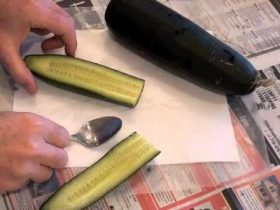The beautiful colors of the flowers in spring and the amazing fragrances make lilacs among our favorite landscape plants and they’re very common in many gardens. But just as commonly, many gardeners don’t fully understand how and when to prune lilacs. So I’ll help you with that today as I show you how I prune my lilacs.
Hi, I’m Gardener Scott and I’m standing in front of my lilac bushes in the landscape of the house that I recently moved into. And they’re quite overgrown and in drastic need of pruning. If you look, there’s no flowers and that means it’s the ideal time to prune these lilac. I had flowers just a few short weeks ago, but they’ve faded and now’s the time to prune.
The lilac is a plant that sets the buds for next year’s flowers right after this year’s flowers begin to fade. So by pruning now I can ensure that I’ll have some flowers next year. It’s a very common problem and a question I’ve received a lot, which is… why isn’t my lilac flowering? Well, it’s probably because the gardener waited too long to prune.
Because if we wait till winter like we do with dormant trees and I cut back this plant, I’m probably cutting off those flower buds. So next year I’ll have no flowers. I’ll have a pruned plant, but I won’t have any of that beauty and that wonderful fragrance. So the key is to do your pruning right after the flowering.
Get the plant cut back and then the buds will develop and you’ll have flowers next year. There are three basic ways of pruning lilacs and I’ll be talking about all three. The first is for a plant that has been regularly pruned and it’s just a maintenance function to clean up the plant and keep it at a manageable size.
The second is for a plant like this, that still has some good size, but just has some stems that have really overextended. And the third is for a plant that’s just gone totally crazy and really needs to be rejuvenated. So let’s begin discussing the first type which is just to keep a plant manageable, under control.
It’s not absolutely necessary to do it every year, but you can. These faded flowers can stay on the plant, but they will start to set seed pods and developing seeds takes a lot of energy from the plant. So by pruning off these tips where the seed heads are beginning to develop. We’re adding some energy back to the plant and also by pruning at this time we’ll be stimulating new growth.
That new growth will help make a bushier plant and eventually will mean the entire bush will be covered with flowers. For this cleanup type of pruning I’ll just come in and I’ll just cut off the spent flowers and you can see all of these seed pods that are starting to develop and now all this energy will go back to the plant.
If it’s been more than a year or the plant is starting to get just a little too large and I want to cut it back to a more manageable size shape, I look for a branch that sets back into the plant aways and I’ll come about a quarter inch from it and I’ll just cut off the branch above it. If I also see a dead or dried branch, I’ll cut that off as well.
And now this little branch right here will continue to grow. But it’s growing with me in charge and the plant is much more under control. As the lilac grows it will send up new plants along the root system. If you want the plant to extend in a flowerbed you can leave these, but as part of the regular maintenance and if you don’t want the plant to spread, just come in and cut off all these young plants.
You can grow your lilac into whatever size you want, but about six to eight feet, about two meters, is really a good height and this type of pruning where we just cut back the tips to another branch is a good way to keep that size. But when it gets big like this one and we really need to cut it back, more drastic action is required.
So I’m going to take out some of these bigger stems all the way to the ground because they’re no longer producing any flowers along this stem. They’re only producing flowers at the very top. So to get full bloom all the way around the plant I need a more compact plant and I’m taking these large ones out to stimulate that new growth, and to give me all those flowers and fragrance that I’m looking for.
It’s important to remember, just like with just about any pruning, I only want to remove about 1/3 of the plant in any given year. And there’s a lot of really long stems so I’m going to use a three-year process. I’ll take out about a third of the stems this year. I’ll take about a third next year and in that third year, I’ll take another third.
And by then I should have a relatively nicely sized two-meter plant that is filled with flowers. When I’m trying to decide which of these big stems to take out first I’ll be looking for older ones and this wrinkled bark and some of this damage along this stem and the one behind it shows that this is an older stem.
So I think it should be one of the first to go. To take these big stems out I’ll be using a handsaw. I like this because it folds, it’s easy to store. When I open it up the same mechanism that closes it keeps it locked so it stays safe. And now I’ll just go in and cut this big tall one as close to the ground as I can.
Whenever you prune you should look for dead, diseased or damaged branches to prune out. Now, this one right here… it is growing off to the side which isn’t ideal, but I noticed some damage about halfway up the stem. So I’ll be taking this one out first. And right behind it there’s actually new growth so these are the stems that will be taking over for the ones that I’m taking out.
And now I’m giving them room to grow. This one right here is also got some dead spots on it so I’ll prune this out while I’m down here. And now I’ll get to this big one and take it down. This branch extends out quite a ways and so I want to cut it off. As I follow it into the plant I can see that it’s coming from this junction right here, but I also see that this part of the stem only extends out here.
So this whole section right here, I want to keep. So what I’ll do is I’ll cut this off all the way back and keep these shorter branches growing. I don’t need to cut it all the way to the ground. The pruners are great, especially large ones like this for branches up to about 3/4 of an inch.
The saw works great for those stems that are about 2 inches and larger. And for everything in between I have loppers. So I’ll be taking this long branch off with my loppers. And that makes pretty short work of those medium-sized branches and stems. So I finished pruning this lilac. I think it looks pretty good.
There’s still a lot of really tall stems. It’s kind of lanky. But this is the first of a three-year process. I took off about a third of the plant, maybe a little bit more. But with all that new growth back there, it now has sun and room to grow and next year when I take out some of these longer branches and stems it’ll start to balance out.
Now, you saw that this can get up to 15 feet tall, which is why I recommend that six to eight foot range to keep things manageable. If the plant is totally out of control with all of the stems 10 to 15 feet tall, that brings us to that third method of pruning and that’s to cut everything off. Down to about 6 to 8 inches.
.. all of the branches. Because we really want to rejuvenate the plant. It’s just gotten too big. This one… I was able to pick and choose, especially with that new growth and I didn’t have to be so drastic with cutting everything down. But if your plant really is wild and you just don’t know what to do with it, just lop and cut everything off to about this tall.
Remember that a lilac should be a big bush and not a small tree. When it’s bushy you’ll get all the flowers. When it’s like a tree you’ll only get flowers at the very top. Aim for about 10 to 12 main stems between 1 and 2 inches in diameter and you’ll be perfect. That lilac is done.
Now I need to work on this one, which is much more manageable and should be an easier job. If you have any questions about pruning your lilacs – the big overgrown ones or the more manageable ones – well, then just let me know below. If you want to see more of these gardening videos, well, then subscribe to the Gardener Scott channel and click on the bell so you know when new ones come out.












Leave a Reply